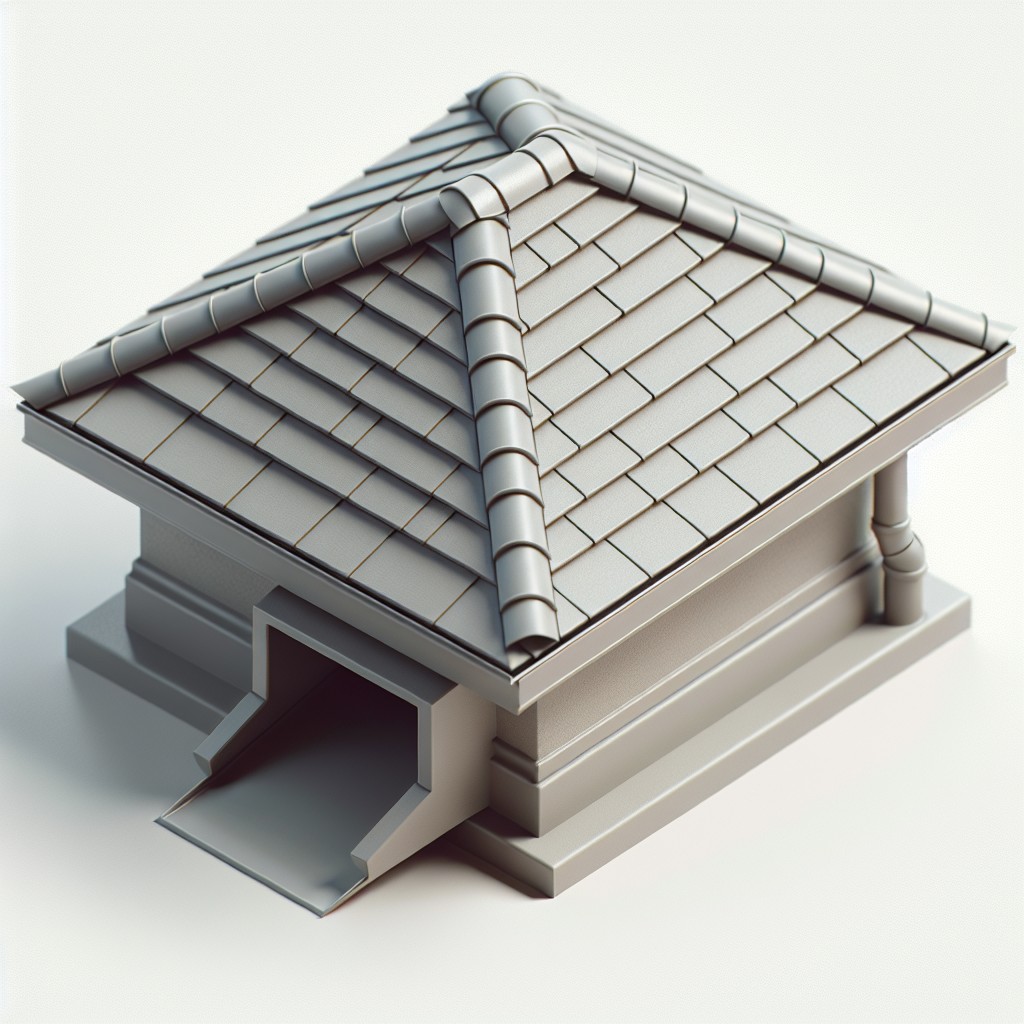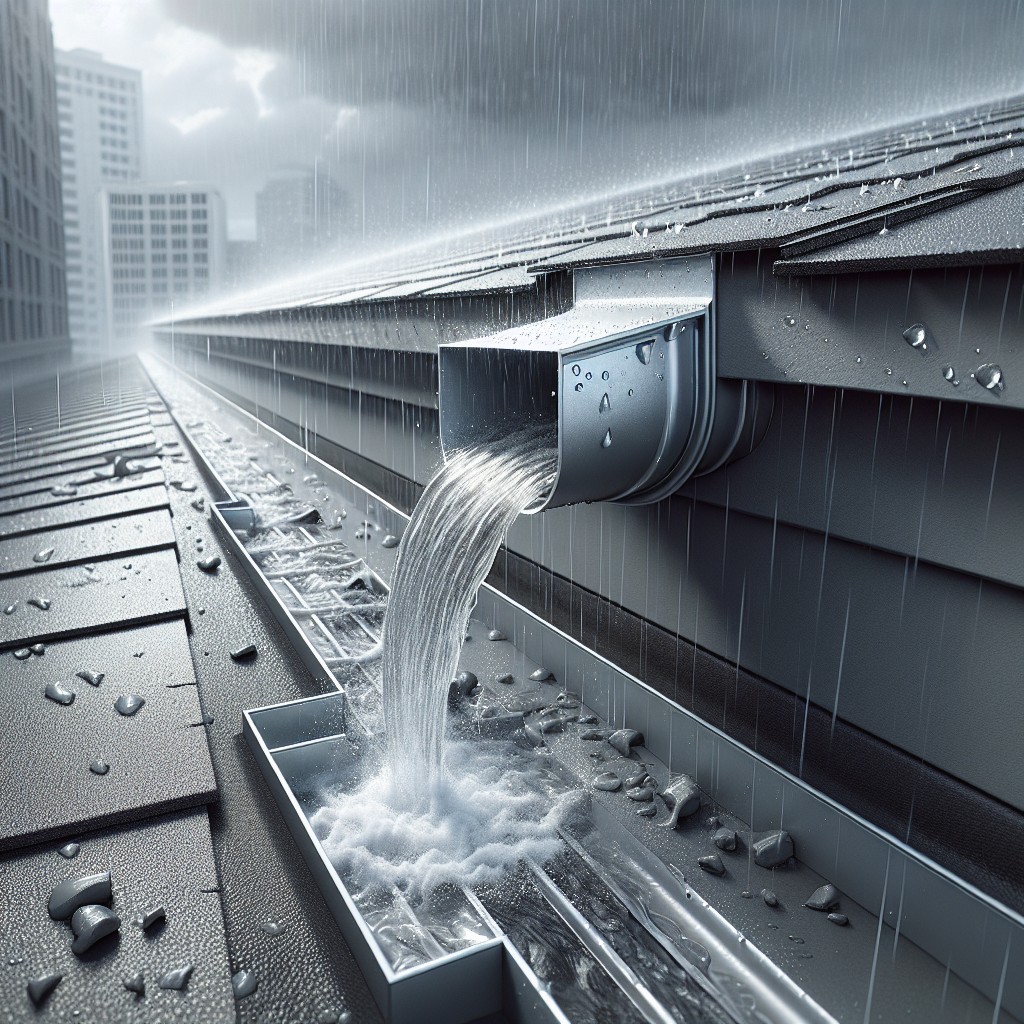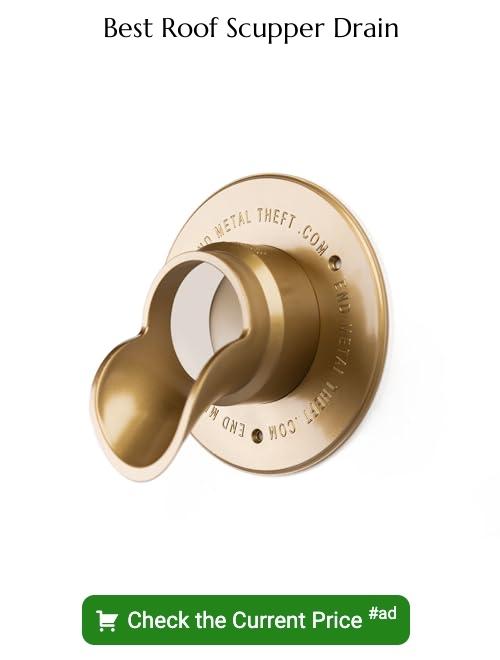Last updated on
Understanding what a scupper on a roof is becomes crucial because it plays a vital role in maintaining a long-lasting and healthy roof.
Key takeaways:
- Roof scuppers are openings that allow water to exit from flat or low-slope roofs.
- They prevent water accumulation and extend the lifespan of the roof.
- Scuppers can be categorized based on design and functionality.
- They should be strategically placed and sized, properly flashed and sealed, and connected to downspouts for optimal performance.
- Scuppers are a reliable solution for flat roofs, but assessing specific needs is crucial for optimal performance.
Definition of Roof Scupper

A roof scupper is a crucial feature on flat or low-slope roofs. It is essentially an opening that allows water to exit from the roof surface. Often found at the edge or in the parapet walls that surround the roof, these openings are part of the drainage system, which targets the prevention of water accumulation and damage.
Scuppers are designed in various shapes and sizes, commonly rectangular or circular, and work by channeling water from the roof to a downspout or leader effectively, ensuring optimal roof performance and longevity.
Functions of Roof Scuppers

Roof scuppers serve as critical components for managing water on flat or nearly flat roofs. Their primary function is to provide an outlet for rainwater, reducing the risk of water accumulation that can lead to leaks or structural damage.
By channeling water away from the roof surface, they also help to extend the lifespan of the roofing membrane and underlayment. In regions with heavy snowfall, scuppers facilitate the escape of melted snow, preventing potential ice dams.
Additionally, they can be integrated into the overall aesthetic of a building, offering architectural appeal while maintaining their utilitarian purpose. Proper positioning and sizing are essential to ensure they perform effectively, especially during heavy downpours.
Types of Roof Scuppers
Roof scuppers can be categorized based on their design and functionality. The thru-wall scupper is one common type, installed through a curb or wall on the roof’s edge, allowing water to exit directly out and away from the building. Parapet scuppers, on the other hand, are found in buildings with parapet walls; the scupper is cut into the wall above the roof line.
There are also angle scupper designs, which direct water flow from the roof at a particular angle, typically to a downspout or a designated drainage area. Additionally, some scupper designs incorporate a spout or tube extending from the opening to help control the direction and flow of water.
The choice of scupper depends on factors such as roof size, architecture, anticipated water volume, and aesthetic preferences. When selecting the appropriate type, it’s also essential to consider local building codes and weather patterns, which can influence both design choice and sizing requirements.
The Difference Between a Roof Scupper, a Drain, and a Gutter
Understanding the distinctions between scuppers, drains, and gutters is key in grasping roof drainage systems.
Scuppers: These are openings on the edges of flat or low-sloped roofs that allow water to flow off directly. They often empty out over the side of the building, potentially into a downspout that runs along the exterior wall.
Drains: Similar to drains in a floor or bathtub, roof drains are typically set into the roof surface itself. They collect water that pools on the roof and funnel it into pipes beneath the roof membrane, which carry the water away from the building without exposing the sides to water run-off.
Gutters: Gutters are attached to the eaves of roofs on any incline. They catch rainwater as it runs off the roof edge, then redirect it through a linked network of downspouts that dispense the water at a safe distance from the building’s foundation.
Crucially, while gutters and scuppers perform a similar function by directing water away from the building, gutters are more common on residential sloped roofs, while scuppers are more suited to flat commercial structures. Drains, on the other hand, are integrated into the roof itself, making them less visible and allowing for internal drainage systems within larger or more complex buildings.
Installation of Roof Scuppers
Successful installation of roof scuppers requires precision and adherence to building codes. These are key points to consider during the installation process:
Placement and Sizing: Scuppers should be strategically placed at low points on the roof or in areas where water tends to pool. Sizes vary but must be adequate to handle the expected volume of water without overflow.
Opening Creation: A section of the roof edge or parapet wall must be cut out to accommodate the scupper. The opening should align with the interior angle of the roof to channel water effectively.
Flashing and Sealing: To prevent leaks, the scupper must be properly flashed — integrated into the roof’s waterproofing system. Sealants are applied around the edges to ensure a watertight connection between the scupper and the roof material.
Downspout Incorporation: In some designs, downspouts are connected to scuppers to direct water away from the building’s foundation. Ensuring a proper fit between the scupper and the downspout is vital for preventing backups and leaks.
Maintenance Access: Consideration for future maintenance should be factored into the installation; scuppers must be accessible for clearing debris and inspection.
Building Codes Compliance: Installers must follow local building codes for dimensions, materials, and installation methods to ensure safety and functionality.
By focusing on these essential points during installation, roof scuppers can provide an effective solution for water management on flat or low-slope roofs.
Materials Commonly Used for Scupper Boxes
Scupper boxes are crafted from a variety of materials to accommodate different architectural styles, climates, and budgetary considerations. Galvanized steel, commonly chosen for its durability and resistance to corrosion, offers a robust solution for climates with variable weather. Aluminum, a lighter option, is favored for its rust resistance and ease of installation. Copper presents a premium choice, appealing for its longevity and the elegant patina it acquires over time. PVC and TPO are cost-effective, modern materials that provide leak-free performance, especially in commercial roofing applications. These materials can also be painted or coated to match the building’s aesthetic, ensuring functionality does not compromise visual harmony.
Advantages and Disadvantages of Roof Scuppers
Scuppers offer an efficient method for directing water off flat roofs, minimizing standing water and the associated risks of leaks and structural damage.
Their simple design enables easy maintenance and reduces the likelihood of clogs that can plague traditional drainage systems.
Due to their position above the roof line, scuppers are less prone to freezing compared to internal drainage systems which reduces the chances of ice-related blockages.
Despite these benefits, scuppers are not without limitations.
They are most effective on buildings with an adequate slope to facilitate water flow towards the outlets.
In heavy rain or snow scenarios, scuppers may be insufficient to handle the volume of water if not properly sized during installation.
Additionally, if a scupper is installed too high above the roof’s surface, it could lead to excess water accumulation, potentially resulting in ponding and increased roof wear.
Overall, while scuppers are a reliable solution for many flat roofing scenarios, assessing the building’s specific needs and climate considerations is crucial to ensure optimal performance.
Alternative Roof Drainage Devices
In addition to scuppers, building designers often employ other methods to manage rooftop water runoff. One such device is an inner roof drain, typically located in the center of a flat roof and piped through the building’s interior. These are especially useful in climates prone to snow and ice, which can block scuppers.
Gutters are another common solution, installed along the roof’s edge to catch and direct water horizontally to downspouts. While effective, gutters require regular maintenance to prevent clogs and damage.
Downspouts are essential to the functionality of gutters, channeling water from the gutters to the ground or stormwater management systems.
Additionally, architects may use drip edges, metal flashing installed at the edges of the roof to direct water away from the fascia and into the gutter system.
A newer alternative, the siphonic roof drain system, uses smaller pipes and less roof pitch to create a vacuum, rapidly pulling water from the roof. Though more complex, this system can be efficient in water removal and space-saving.
Each alternative has its context of use, maintenance needs, and installation requirements, making it important to assess the specific conditions and needs of a building before choosing the best roof drainage device.
Installation Cost of a Roof Scupper
Determining the installation cost of a roof scupper involves several variables. Firstly, the size and complexity of the scupper will influence the price; larger scuppers or custom shapes can be more expensive. Material choice also affects the cost, with options ranging from affordable PVC to more pricey copper or stainless steel. The labor rate in your region and the complexity of your roofing system will further contribute to the overall expense.
An existing roof may require retrofitting which, depending on the amount of modification to the structure, can increase the cost compared to a straightforward installation on a new build.
Additionally, the number of scuppers needed to ensure proper drainage will play into the total investment. The installation process can cost anywhere from a few hundred to several thousand dollars—requesting a detailed quote from a licensed contractor can provide a clearer picture tailored to your specific roofing requirements.
Keep in mind, while upfront costs may seem significant, a well-executed scupper installation is crucial to protect your property from water damage, ultimately conveying long-term savings.
When to Call a Professional for Roof Scupper Issues
Identifying the right time to seek professional assistance can ensure the long-term functionality of your roof scupper. Consider calling a roofing expert if you notice:
- Persistent Clogs: If debris consistently obstructs the water flow even after cleaning, there may be structural issues needing attention.
- Visible Damage: Cracks, holes, or corrosion in the scupper indicate a need for repair or replacement.
- Water Pooling: If water remains on the roof long after rain, the scupper may not be adequately sized or positioned.
- Interior Leakage: Water stains or leaks inside your building may suggest a compromised scupper-to-drain connection, requiring immediate action.
- Upgrade Planning: When contemplating roof upgrades or replacements, professionals can advise on optimizing the scupper system for better drainage.
In these scenarios, expert diagnosis helps prevent further damage and costly repairs, ensuring your roof scupper is efficiently managing water runoff.
FAQ
How does a roof scupper work?
A roof scupper functions as an outlet in parapet walls or gravel stops on flat and built-up roofs, enabling the drainage of surplus water and potentially operating with gutters and downspouts to channel the water flow towards a specific location.
What is difference between scupper and drain?
The difference between a scupper and a drain is that a scupper allows water to escape through a hole or fixture on a sidewall, while a drain forces water into a confined space.
What does a scupper do?
A scupper functions as a drainage mechanism on a roof, primarily utilized in commercial buildings, designed to remove rainwater through holes located along the building’s edge.
Where do you put a scupper on a roof?
A scupper is typically installed on any edge of a flat roof, positioned lower than the roof surface, especially when there is a problem of water pooling.
What specific materials are commonly used in the construction of roof scuppers?
Roof scuppers are commonly constructed from materials like stainless steel, galvanized steel, copper, and PVC (polyvinyl chloride).
How often should a roof scupper be maintained for optimal performance?
A roof scupper should be maintained at least twice a year for optimal performance.
Is there any specific roof design that benefits more from a scupper over a traditional drain system?
Flat roofs, particularly used in commercial construction, benefit more from scuppers as they facilitate better water drainage and prevent accumulation compared to traditional drain systems.





